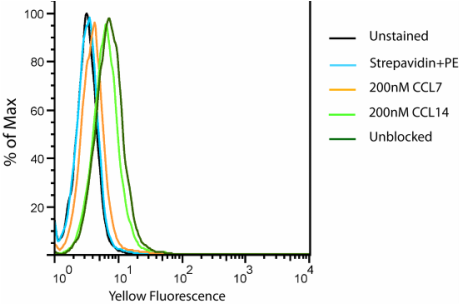Biotinylated Human CCL2 (MCP-1)
Catalog Number: B-CCL2-2ug, B-CCL2-10ug, B-CCL2-50ug, B-CCL2-100ug
Lyophilized sample, >97% Purity, EC50 = 1.26nM
Catalog Number: B-CCL2-2ug, B-CCL2-10ug, B-CCL2-50ug, B-CCL2-100ug
Lyophilized sample, >97% Purity, EC50 = 1.26nM

Product Data Sheet (PDF)
Safety Data Sheet (PDF) Also available unlabeled: Wildtype Human CCL2 Standard Products Ship within 1-2 Business Days For bulk orders, please email us at [email protected] for a quote |
Stock Sizes: 2ug, 10ug, 50ug, 100ug, and 1mg
Also available in custom sizes, email for a custom quote. |
BACKGROUND
Monocyte chemoattractant protein-1 (MCP-1/CCL2) is produced by many cell types at sites of inflammation. It regulates chemotaxis and transendothielial migration of monocytes, as well as memory T cells and natural killer cells by interacting with their membrane surface receptor CCR2. MCP-1 has also been implicated in a number of disease states, such as rheumatoid arthritis, atherosclerosis, autoimmune diseases, tumor progression, and HIV infection. This cytokine displays chemotactic activity for monocytes and basophils but not for neutrophils or eosinophils. It binds to chemokine receptors CCR2 and CCR4.
Biotinylated CCL2 is made using the enzymatic method, which has several advantages over chemical biotinylation methods. The attachment of biotin at a specific lysine residue within the C-terminal avi tag sequence is nearly 100% complete, and leads to a modified chemokine with functionalities comparable to those of the unmodified CCL2 in migration assay. Combining with avidin analogues conjugated to various fluorescent labels, biotinylated CCL2 is useful in studies on receptor identification, distribution, chemokine binding, and other cellular assays. They serve as great tools in visualization and quantification, and replace the needs for radioactively labeled chemokines.
Monocyte chemoattractant protein-1 (MCP-1/CCL2) is produced by many cell types at sites of inflammation. It regulates chemotaxis and transendothielial migration of monocytes, as well as memory T cells and natural killer cells by interacting with their membrane surface receptor CCR2. MCP-1 has also been implicated in a number of disease states, such as rheumatoid arthritis, atherosclerosis, autoimmune diseases, tumor progression, and HIV infection. This cytokine displays chemotactic activity for monocytes and basophils but not for neutrophils or eosinophils. It binds to chemokine receptors CCR2 and CCR4.
Biotinylated CCL2 is made using the enzymatic method, which has several advantages over chemical biotinylation methods. The attachment of biotin at a specific lysine residue within the C-terminal avi tag sequence is nearly 100% complete, and leads to a modified chemokine with functionalities comparable to those of the unmodified CCL2 in migration assay. Combining with avidin analogues conjugated to various fluorescent labels, biotinylated CCL2 is useful in studies on receptor identification, distribution, chemokine binding, and other cellular assays. They serve as great tools in visualization and quantification, and replace the needs for radioactively labeled chemokines.
|
SPECIFICATIONS
Source: E. coli derived Accession # P13500-2 (24-99) Modification: Biotin at C-Terminal Formulation: Lyophilized Carrier Protein: None Predicted Molecular Mass: 11.085 kDa Extinction Coefficient: 14,180 M-1 cm-1 Actual Molecular Mass: 11.085 kDa by ESI MS Endotoxin Level: <0.01 EU per 1μg of the protein by the LAL method Purity: > 97% by SDS PAGE |
PREPARATION AND STORAGE
Reconstitution: Spin sample prior to reconstitution. Recommended concentration of 100μg/mL in sterile water. Shipping: Room Temp Stability and Storage: Avoid repeated freeze-thaw cycles. • 12 months from date of receipt, -20 to -70 °C as supplied. • ChemoTactics suggests using immediately after reconstitution. • 1 month, -20 to -70 °C under sterile conditions after reconstitution. |
|
Flow Cytometry: Uptake of biotin-CCL2 by THP1 cells (dark green) is abolished by the addition of CCL7 (orange) but not CCL14 (light green), suggesting a CCR2-specific internalization. THP1 cells are not stained in the absence of biotin-CCL2-biotin (cyan).
Flow cytometry protocol 20nM Biotinylated CCL2 with Streptavidin PE on THP-1 Cells
|
Migration Assay: Cells expressing recombinant CCR2 were assayed for migration through a transwell filter at various concentrations of MCP-1. Responses are expressed as the % of total input cells (Blue: wild type; Red: biotinylated).
Migration Assay protocol Activity: EC50 = 1.26nM determined by migration assay of THP-1 Cells
|
For bulk orders or custom sizes, please contact us and we can provide this for you.
|
|
|
|
|
|
REFERENCES
1. “Monocyte Chemoattractant Protein-1 (MCP-1): An Overview” Deshmane S., Kremlev S., Amini S., Sawaya B. J Interferon Cytokine Res. 29: 313–326 (2009)
2. "Human monocyte chemoattractant protein-1 (MCP-1). Full-length cDNA cloning, expression in mitogen-stimulated blood mononuclear leukocytes, and sequence similarity to mouse competence gene JE" Yoshimura T., Yuhki N., Moore S. K., Appella E., Lerman M. I., Leonard E. J. FEBS Letters 244: 487–493 (1989)
3. “Monocyte chemoattractant protein-1: A key mediator in inflammatory processes” Melgarejo E., Medina M., Sánchez-Jiménez F., Urdiales J. Int J Biochem Cell Biol 41: 998-1001 (2009)
1. “Monocyte Chemoattractant Protein-1 (MCP-1): An Overview” Deshmane S., Kremlev S., Amini S., Sawaya B. J Interferon Cytokine Res. 29: 313–326 (2009)
2. "Human monocyte chemoattractant protein-1 (MCP-1). Full-length cDNA cloning, expression in mitogen-stimulated blood mononuclear leukocytes, and sequence similarity to mouse competence gene JE" Yoshimura T., Yuhki N., Moore S. K., Appella E., Lerman M. I., Leonard E. J. FEBS Letters 244: 487–493 (1989)
3. “Monocyte chemoattractant protein-1: A key mediator in inflammatory processes” Melgarejo E., Medina M., Sánchez-Jiménez F., Urdiales J. Int J Biochem Cell Biol 41: 998-1001 (2009)
Support: [email protected]
For Research use only, Not for use in Humans.
For Research use only, Not for use in Humans.




